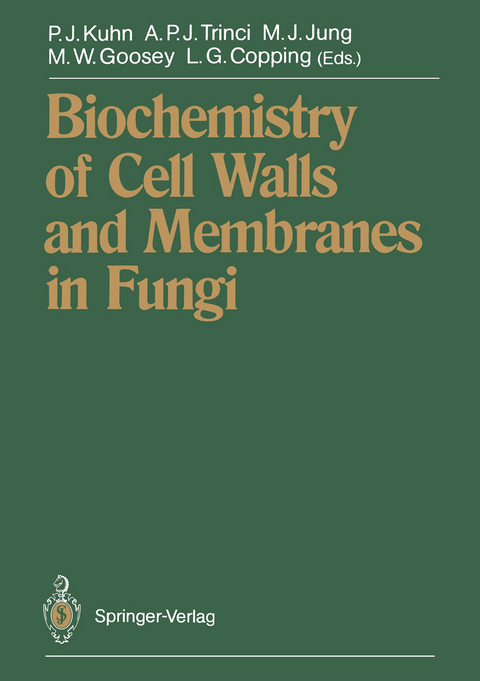
Biochemistry of Cell Walls and Membranes in Fungi
Springer Berlin (Verlag)
978-3-642-74217-0 (ISBN)
1 Cell Walls and Membranes in Fungi - An Introduction.- References.- 2 Fungal Cell Walls - A Review.- 1 Introduction.- 2 The Chemistry and Architecture of the Fungal Cell Wall.- 3 Synthesis of Cell Wall Polymers.- 4 Stability of the Cell Wall.- 5 Wall Formation During Protoplast Regeneration.- 6 Genetics and the Fungal Wall.- 7 The Cell Wall as a Target.- 8 The Cell Wall as an Interactive Surface.- 9 The Protective Role of the Cell Wall.- 10 Cell Wall Enzymes, Wall Porosity and Enzyme Secretion.- 11 Concluding Statement.- References.- 3 Chitin Synthesis in Yeast (Saccharomyces cerevisiae).- 1 Introduction.- 2 Zymogen Nature of Chitin Synthetase.- 3 Intracellular Distribution of Chitin Synthetase.- 4 Cloning of a Chitin Synthetase Structural Gene.- 5 A New Chitin Synthetase.- 6 Cloning of the Chitin Synthetase 2 Structural Gene.- 7 Requirement of Chitin Synthetase 2 for Cell Division.- 8 Chitin Synthetase 1 - A Repair Enzyme?.- 9 The Present Status of Chitin Synthesis in Yeast.- References.- 4 A Novel Computer Model for Generating Cell Shape: Application to Fungal Morphogenesis.- 1 Introduction.- 2 Current Concepts of Wall Growth in Fungi.- 3 A Model of Wall Growth Based on Vesicles.- 4 Computer Simulation of Morphogenesis.- 5 Mathematical Model for Hyphal Growth.- 6 Relationship of Spitzenkörper to VSC.- 7 The VSC Concept and Mechanisms for VSC Displacement.- 8 Simulations of Morphogenetic Processes in Fungi.- 9 Limitations.- 10 Discussion and Conclusions.- References.- 5 Inhibition of Chitin Metabolism.- 1 Chitin Metabolism as a Target for Antifungal Agents.- 2 Chitin Synthase.- 3 Glutamine-Fructose-6-P-Aminotransferase.- 4 Chitinase.- 5 Conclusions.- References.- 6 Wall Structure, Wall Growth, and Fungal Cell Morphogenesis.- 1 Introduction.- 2 Alkali-Insoluble?-Glucan in the Mature Wall Forms Part of a Glucosaminoglycan-Glucan Complex.- 3 Secondary Structures in the Glucosaminoglycan-Glucan Wall Complex.- 4 Apical Biosynthesis and Morphogenesis of the Hyphal Wall.- 5 Mycelium-Yeast Transitions.- 6 Diffuse Extension of Hyphal Walls.- 7 Conclusions.- References.- 7 Cellulose and ?-Glucan Synthesis in Saprolegnia.- 1 Introduction.- 2 Synthesis and Deposition of Cell Wall Glucans in Saprolegnia hyphae.- 3 Cellulose Synthesis and Hyphal Morphogenesis.- 4 ?-Glucan Synthases from Saprolegnia.- 5 Purification of Glucan Synthases from Saprolegnia.- 6 Conclusions.- References.- 8 Synthesis and Function of Glycosylated Proteins in Saccharomyces cerevisiae.- 1 Introduction.- 2 Biosynthetic Pathways.- 3 Functional Aspects.- 4 Summary.- References.- 9 Lipids in the Structure and Function of Fungal Membranes.- 1 Introduction.- 2 The Membrane System.- 3 Membrane Structure.- 4 Membrane Composition.- 5 Functions of Membrane Lipids.- 6 Influence of Environment, Nutrition, and Development on Membrane Composition and Function.- 7 Conclusions.- References.- 10 Importance and Role of Sterols in Fungal Membranes.- 1 Introduction.- 2 Ergosterol: Does It Meet the Requirements of Fungal Membranes?.- 3 What Are the Consequences for the Cell to Synthesize Alkylated Sterols?.- 4 Why Ergosterol Instead of Cholesterol?.- References.- 11 HMG-CoA to Isopentenyl Pyrophosphate - Enzymology and Inhibition.- 1 Hydroxymethylglutaryl-Coenzyme A (HMG-CoA) Reductase.- 2 Isopentenyl Pyrophosphate Isomerase (IPPI).- 3 Inhibition of Mevalonate-5-Pyrophosphate Decarboxylase.- References.- 12 Isopentenyl Diphosphate to Squalene - Enzymology and Inhibition.- 1 Introduction.- 2 Isopentenyl Diphosphate: Dimethylallyl Diphosphate Isomerase.- 3 Farnesyl DiphosphateSynthetase.- 4 Squalene Synthetase.- 5 Conclusions.- References.- 13 Squalene Epoxidase - Enzymology and Inhibition.- 1 Introduction.- 2 Enzymology.- 3 Squalene Epoxidase Inhibitors.- 4 Squalene Epoxidase Inhibitors as Antifungal Agents.- References.- 14 Inhibition of Sterol Biosynthesis in Higher Plants by Analogues of High Energy Carbocationic Intermediates.- 1 Introduction.- 2 Inhibition of Phytosterol Biosynthesis by Carbocationic HEI and Transition State Analogues.- 3 Conclusions.- References.- 15 Lanosterol to Ergosterol - Enzymology, Inhibition and Genetics.- 1 Introduction.- 2 Antifungal Compounds and Their Activities.- 3 Fungal Cytochrome P-450.- 4 Conclusions and Implications for the Discovery of Novel Antifungal Agents.- References.- 16 Biosynthesis and Role of Phospholipids in Yeast Membranes.- 1 Regulation of Phospholipid Synthesis in S. cerevisiae - A Review.- 2 Regulation of Phospholipid Synthesis in S. pombe - Introduction.- 3 Roles of Phospholipids in S. cerevisiae and S. pombe.- References.- 17 Inhibitors of Phospholipid Biosynthesis.- 1 Introduction.- 2 Phospholipid Structure and Biosynthesis.- 3 Inhibitors of Phospholipid Biosynthesis.- 4 Validamycin and Edifenphos as Paramorphogens.- References.- 18 Transduction of the Calcium Signal with Special Reference to Ca2+-Induced Conidiation in Penicillium notatum.- 1 Introduction.- 2 Regulation of Intracellular Calcium.- 3 Calcium as an Intracellular Regulator.- 4 The Role of Calcium in Fungi.- 5 Ca2+, Signal Transduction and Morphogenesis in Fungi.- 6 Ca2+ and Signal Transduction in Penicillium notatum.- 7 Concluding Comments.- References.- 19 Structure and Function of Fungal Plasma-Membrane ATPases.- 1 Introduction.- 2 Membrane Appearance of the Plasma Membrane (PM) ATPase.- 3 FunctionalProperties of the Proton Pump.- 4 Chemistry of the Enzyme.- 5 Primary Structure and Predictions.- 6 Models for Proton Pumping.- 7 Current Directions.- References.
| Erscheint lt. Verlag | 13.12.2011 |
|---|---|
| Zusatzinfo | XIII, 327 p. |
| Verlagsort | Berlin |
| Sprache | englisch |
| Maße | 170 x 242 mm |
| Gewicht | 595 g |
| Themenwelt | Naturwissenschaften ► Biologie ► Biochemie |
| Naturwissenschaften ► Biologie ► Mikrobiologie / Immunologie | |
| Naturwissenschaften ► Biologie ► Zellbiologie | |
| Schlagworte | biochemistry • Biology • Calcium • Cell • cell wall • Fungi • glycoprotein • Membrane • Molecular Biology • Protein • proteins • Regulation |
| ISBN-10 | 3-642-74217-3 / 3642742173 |
| ISBN-13 | 978-3-642-74217-0 / 9783642742170 |
| Zustand | Neuware |
| Haben Sie eine Frage zum Produkt? |
aus dem Bereich


